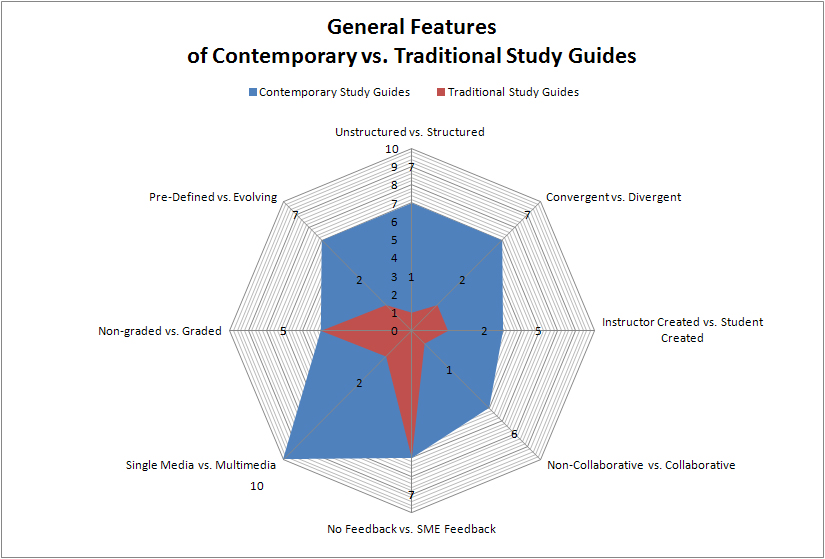So what about study guides today? Are they still in use? How are they being used? How are they being developed?
Study guides still have validity and usefulness today. After all, students still need the cognitive load lightened, and they can benefit from the insights of subject matter experts.
In any of these circumstances, study guides may add value.
Study guides are still used to help learners synthesize the learning pulled from disparate sources. With so many solid types of contents online, instructors in face-to-face (F2F) and online (and hybrid / blended) courses draw from the Web. With so many voices and sources in play, learners have to put in extra work to create coherence and to logically synthesize information.
An example comes from "Ideologies: Their Origins and Impact" [a standard full-semester-term face-to-face (F2F) course]. Here, the instructor required the work to be done prior to the midterms and final. The instructor responded to the contents, and she advocated for high quality responses. That feedback loop and substantive instructor-to-learner feedback enhanced the learning value of the straightforward set of questions. Without that loop, the study guide questions could be seen as just a list of comprehension questions (that helped synthesize the learning). The fact that the study guide responses were graded and used strategically before assessments enhanced their learning value.
Study guides are still used to integrate mass media for learning, although that mass media may now be an electronic game (which needs setup, coordination, and debriefing for learning values). Study guides are used to guide learners through digital simulations like laboratory experiments. They are used for on-ground local learning such as on a field trip.
The wide availability of authoring tools for digital contents enables a wide variety of study guides. The following elements may be used in a stand-alone way or in a mixed-content way:
Digital object types
Systems
What are some ways that designers of study guides may change things up to enhance the learning (and the form)? The idea is to avoid locking in to certain assumptions but to be open to various types of structuring learning.

* These numbers are not the result of empirical research but a generalization from observations of study guides found in online repositories. This "filled radar chart" illustration is used to introduce the general dimensions and to offer a preliminary conceptualization of how this might look.
|
Unstructured vs. Structured |
Convergent vs. Divergent |
Instructor Created or Student Co-Created |
Non-Collaborative vs. Collaborative |
No Feedback vs. SME Feedback |
Single Media vs. MultiMedia |
Non-Graded vs. Graded |
Pre-Defined vs. Evolving |
|
|
Contemporary Study Guides |
7 |
7 |
5 |
6 |
7 |
10 |
5 |
7 |
|
Traditional Study Guides |
1 |
2 |
2 |
1 |
7 |
2 |
5 |
2 |
Unstructured vs. Structured: Sense of pre-determined order
Divergent vs. Convergent: Open-ended or close-ended study guides; complex learning that requires innovation or declarative knowledge learning requiring rote memorization
Student Co-Created vs. Instructor Created: Study guide sourcing by learners or by the instructor (with some professors using the students' work to create assessments)
Collaborative vs. Non-Collaborative: Study guides used by groups of learners vs. individual learners only
No Feedback vs. SME Feedback: Whether the instructor responds to the student work in their study guides
Multimedia vs. Single Media: The types of multimedia used for the creation of the study guide
Affects Grades Formally vs. Not: The grading of study guides as part of the course
Evolving vs. Pre-Defined: The nature of the study guide as an evolving document with changing elements (and new contents) over time (including over many academic terms and cohort groups of learners) or a pre-defined set of elements with generally pre-determined answers
|
"Study Guides"
One challenge though is that the term is used very broadly—for tutorials and online lessons and other types of learning elements. Give it a try. Put in "study guide" as the search term in the following repository, and you may find what I did.
Multimedia Educational Resource for Learning and Online Teaching (MERLOT) http://www.merlot.org/merlot/index.htm
|
In late June, I posted a call-out to the DEOS electronic mailing list and asked for any examples of study guides used for online learning. I received some links which I'll share in the next few pages. However, two other responses were instructive. One, a head of an online program at a major university, wrote to say that they moved away from study guides five years ago and "toward a more interactive experience" for their students. They basically decomposed their study guide into the learning management system, and they encouraged learners to interact among themselves and with their instructor. Another referred me to excerpts from a published book for basic information for learners who are taking online courses. Both of these respondents saw the "study guide" question as one about the guides to online learning...not domain-specific study guides for particular online courses (which is more what I meant).
A few of the examples of contents follow in the next few pages.